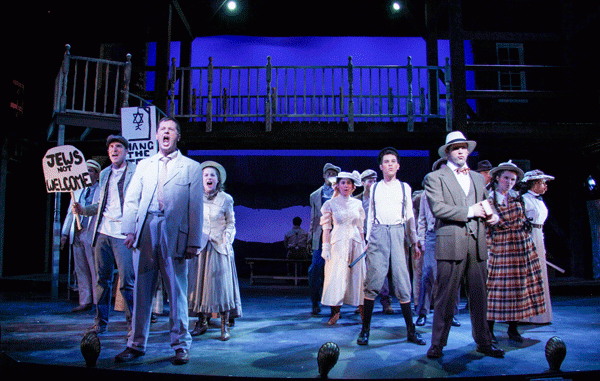
It was the trial of the century that shook a nation and left Americans contemplating the meaning of justice. On April 7, the tumultuous story of The People v. Leo M. Frank took center stage in McKenna Theatre.
In Catherine Doherty’s directorial debut at SUNY New Paltz, she brought to life the award winning Alfred Uhry and Jason Robert Brown musical “Parade.” The show ran for eight performances. Then on Sunday, April 17, the cast and crew transported their last crowd to Atlanta, Georgia in 1913. The emotionally charged production brought social and political issues to the forefront of the theatre.
“It’s strikingly relevant to issues now,” Doherty said. “‘Parade’ is very producible, it has the right size cast, opportunities for students of color, beautiful music and topical issues.”
“Parade” divulges the poignant true story of a native Jewish New Yorker named Leo Frank living in Georgia with his southern wife, Lucille Frank. The climax of the tale occurs when Leo is accused of the murder and rape of a young girl, Mary Phagan, who worked in his pencil factory. From then on, viewers witness the heart-wrenching trial and the themes of Anti-Semitisms, post-Civil War America, racism, corruption and much more.
According to Doherty, this is her second year teaching in the department of theatre arts. She received the directorial role due to her vast experience in directing large-scale musicals, her contractual obligation to direct a production and her great interest in “Parade.”
Auditions were held for two nights in January, callbacks followed on the third day and rehearsal started in mid-February. Doherty said the process consisted of learning the music, staging, choreography, putting it all together and repeating the ritual.
“I preach and teach student actors the importance of being as truthful as possible in the telling of stories,” Doherty said.
Third-year history major Kyle Marra played the lead role of Leo Frank, and he attests to the struggle of playing a real person. He found the content challenging because of its heavy nature. However, the importance of remaining true to the character pushed him to do justice to Leo Frank and his story.
“There were many times in this rehearsal process and even in performances when I would think to myself ‘this actually happened’ or ‘who I am right now was a real person,’” Marra said.
The complexity of this production went beyond the dense material that the actors worked with and permeated through every aspect of “Parade.” A huge automated turntable forced the crew to build up the surface of the stage. The set itself stood two stories tall with a grand staircase leading to the second bridge-like level. Doherty said the complex light and sound design had to accommodate 25 voices singing at different times and places. Approximately 300 pieces of costuming contributed to the realistic setting in the turn of the century American south.
“It took a village to put this show together,” Doherty said.
Third-year theater major Maria Coppola assisted with the choreography and wardrobe crew. She worked backstage for the entirety of the show but on the first night of dress rehearsal she found some time to sit in the audience and watch a few numbers that brought her to tears.
“I think the actors, along with the overall design of the show, told a truthful story,” Coppola said. “It allowed audiences to hear about the lives of real historical figures and events that are so crucial yet rarely discussed in history classes.”
